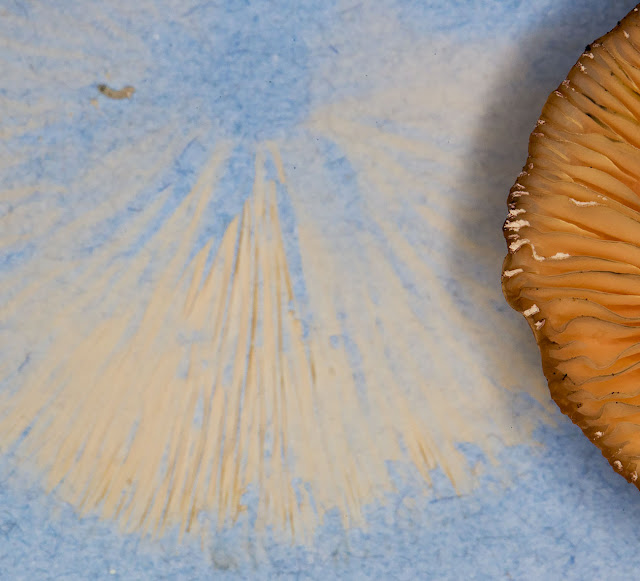 |
| Rhodotus palmatus, Wrinkled Peach. High Elms Country Park, 11 November 2014. |
I've been walking in woodlands for a couple of weeks looking for fungi. In most places they are not abundant, but a few can always be found eventually, sometimes really pretty ones, and in some sites they are everywhere.
This Wrinkled Peach from High Elms is interesting. It only grows on dead elm trees. Now, all the mature elms in this area were killed off by Dutch Elm Disease about 40 years ago. So this dead and fallen trunk must be that old. I know of two more in this area, and there must be many others I am not aware of.
 |
| Rhodotus palmatus, Wrinkled Peach. High Elms Country Park, 11 November 2014. |
This is the underside. Undersides of fungi are often lovely. When people, me included, put fungi on line to get, or confirm, an identification we are sometimes told rather testily to get more details. What are the gills like? How are they attached? And, ideally, look at the spores under a microscope. If not, then at least get a spore print, which will tell you the colour of the spores.
 |
| Rhodotus palmatus, Wrinkled Peach. Spore print, 12 November 2014. |
So here is its spore print. Pinkish, as you can see, and if I anticipate a light coloured print I try to get it on dark paper; and I had some blue lying around.
 |
Collybia butyracea, Butter Cap, being eaten by fungus gnat larvae (Mycetophilidae)
Hayes Common, 9 November 2014. |
But looking at gill attachments can produce some surprises. This is a different species that I cut down the middle, only to find it was hosting a little group of larvae. Finding a sudden handful of wriggly things is an everyday hazard when slicing fungi. Even when they are not obvious, if you leave them out for spore prints and don't sort them out within a day or so, you are likely to find larvae appearing. So I suggest not doing this in a bedroom.
These are fungus gnat larvae. You can also find various beetles.
 |
Collybia butyracea, Butter Cap, being eaten by fungus gnat larvae (Mycetophilidae).
Hayes Common, 9 November 2014. |





No comments:
Post a Comment